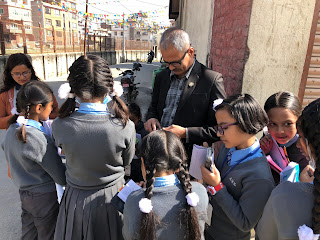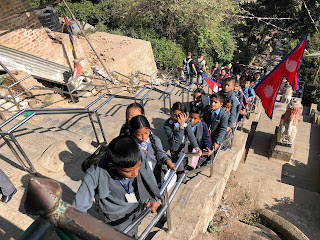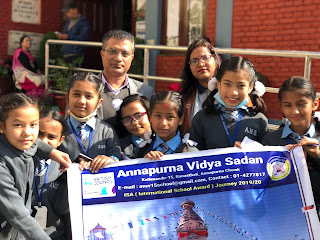Swayambhu Mahachitaya (World Heritage Sites)– For Partner School, Scoala Gimnaziala Vasile Alecsandri, Baia Mare,
Romania
Thanking to entire school team and respected project coordinator
Daniela B. Buda, me ISA coordinator Anil Kr. Yadav (Tyagi Anil Marut) posting article computerized by our one genius student of grade 5, about Swayambhu Mahachitaya in her own word.
AVS - ISA (International School Award) Journey 2019/20
|
‘‘History and symbolic reflection of Swayambhu Mahachitaya’’
|
Hello
dear friends, from Scoala Gimnaziala Vasile Alecsandri, Baia Mare, Romania, School, and
respected project coordinator Daniela B. Buda madam we are very happy to get
updates about Romania Cultural Heritage sites.
Me,
Avilasha Pathak, grade 5, from Annapurna Vidya Sadan School, Kathmandu Nepal, sharing
here about ‘‘History and
symbolic reflection of Swayambhu Mahachitaya’’ to you
all, Under the AVS - ISA Journey
2019/2020.
It
was very fabulous time for me, to know in details about Swayambhu Mahachitaya
stupa by visiting. I must thanks to British Council, Connecting classroom
project, our school and all teachers, mainly Shobha Pathak, Puja Gurung, Malati
Gurung and Tyagi Anil Marut for this grand opportunity.
If
I start sharing about my learning in details now, it will be difficult for you
to register in your mind. So for now, I will share only about ‘‘History and symbolic reflection of Swayambhu Mahachitaya’’
Swayambhu Mahachitaya Stupa is one of the most ancient and holy shrines
in the Kathmandu valley and has been an important Buddhist pilgrimage destination
since 5th century AD.
According to the 15th century Swayambhu purana, Lord
Buddha planted a miraculous lotus that radiated a brilliant light and blossomed
in the lake that once covered the Kathmandu Valley. This lotus later
transformed into a sacred hill on its own and the place came to be known as
Swayambhu, meaning ‘Self-Created’ or ‘Self-Existent’.
A large illusion of
Sakyamuni Buddha was seen on top of the lotus. This illusion was seen by
Manjushri, who came in search of the place. Near the Swayambhu Stupa a shrine has been erected where
Manjushri stood to empty the lake and left his footprints on sacred ground.
These monuments mark the birthplace of the Kathmandu Valley, which developed
into the country of Nepal.
According to the
etiquettes of bodhisattva, he should keep his hair short and clean. However, he
let his hair grow down and got infected with lice. It is said that these lice
jumped out and became monkeys. Thus, the hill is full of monkey.
Legend says on top of Swayambhu
Mahachitaya hill stood a
natural crystal stupa. Buddha, when visiting the place, declared that it was a
wish-fulfilling stupa and whoever is touched by the wind that passes over the
stupa receives the seed of liberation from the cycle of existence.
Swayambhu Mahachitaya is regularly visited by thousands of pilgrims
including Vajrayana Buddhists of northern Nepal and Tibet, Newari Buddhists of
central and southern Nepal, and even people of other faiths.
It is a UNESCO World Heritage Site, goes back to ancient times. The earliest written record
of the Great Stupa of Swayambhu is a 5th century stone inscription. Honored by
kings, monks, and pilgrims alike, the stupa has been restored and repaired on
numerous occasions.
In 1349 it was damaged by an invading
Muslim army and later repaired by King Saktimalle Bhalloka.
In 1505, the yogin Sangye Gyaltsen added
the wheel and spire to the stupa’s dome.
In 1614 the 6th Shamarpa had shrines
built into the stupa in the four cardinal directions. Several important Kagyu
lamas held a consecration ceremony in 1750 after a major renovation.
The famous Bhutanese master Lopön Tsechu
Rinpoche (1918-2003), the late abbot of the Bhutanese Drugpa Kagyu Monastery on
the western side of the stupa, came to Nepal in order to assist his uncle, the
Drukpa lama Sherab Dorje, in restoring and maintaining the stupa during the
early 20th century. The most recent renovation of the Swayambhu Stupa was
completed in May 2010, around 1500 years after its construction. The dome of
the stupa was re-gilded using gold (20 kg). However, a few regions of the
temple were destroyed by lightening in 2011 and earthquake in 2015.
The
base of this stupa is cube shaped. On all four sides, there is a pentagon
shaped Toran. On each side of the
stupa, a pair of eyes is present. This indicates that the God is omnipresent.
Above each pair of eyes, there is another eye, which is the eye of wisdom.
There is Panch Buddha (five Buddhas)
on each side of the stupa. Walk a past the stairs leading to the temple and you
will find two lion statues guarding the entrance. This staircase is the most
recommended route that pilgrims take to enter the stupa, on foot. However, if
you are ready to drive to the west side of the stupa, you can find another
entrance; with lesser steps.
At
the bottom of the staircase on the eastern side, there is a large gate with 12
feet tall Tibetan prayer wheel. It
would take two strong people to move the wheel. For every revolution, a bell
sound is heard. Near the gate, there are numerous small wheels for tourists to
spin and perform prayers. Right before the stairs, you will find three 17th century Buddha statues.
These statues are worshipped by women. Along the stairs, you will find many
inscribed Tibetan stones. You can also spot small shops where merchants sell
such stone replicas to tourists. The stairs will take you through forest region
inhabited with numerous monkeys.
The
main stupa building is a white domed structure. The stupa is filled with
numerous statues and artifacts. From the tower, you can find a 13 level golden
spire. The umbrella on top of the spire
holds a bowl full of precious stones. There are numerous other shrines around
this main building. Each one was donated by kings and other political figures.
To know about the area around the Stupa
in short, you can also refer this diagram. ……. Turn one side and show with finger.

Hopefully, I am able to clarify
you about ‘‘History and symbolic reflection of Swayambhu Mahachitaya’’.
If you want to know more
about Swayambhu Mahachitaya, please write in comment, I will try my best to update more things. You can also refer videos link and pictures of our trip, I will ask my ISA Coordinators to post for you all. Thanks

































































Niciun comentariu:
Trimiteți un comentariu